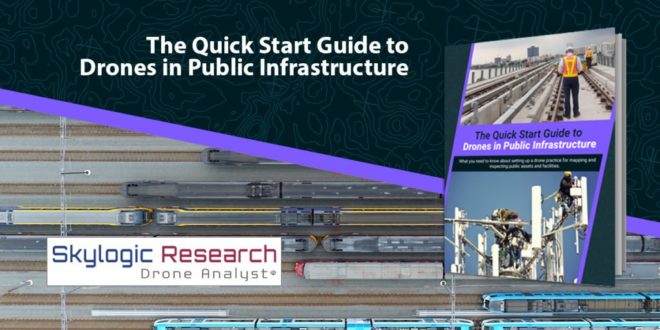Skylogic Research, the leading research and advisory services firm for the commercial drone industry and owner of Drone Analyst®, announced today the release of their Quick Start Guide to Drones in Public Infrastructure. This report is the third in a new series of Skylogic Research white papers, intended to provide a complete primer to drone use in specific industries.
The report, which is authored by CEO and Founder Colin Snow, consolidates Skylogic Research’s best insights into the challenges and solutions drones add to inspecting assets like bridges, dams, highways, towers, and railways. It shows how drones add value to digital representation of physical assets and what information companies and public agencies are gleaning from the data their drones collect.
The paper answers questions like:
- How big is the public infrastructure inspection drone market, and who are the major solution providers?
- How do state DOTs, civil engineers, railroads, and telecommunications firms use drones and what challenges must be addressed?
- What do you need to know about regulations, pilot certification, insurance, and training?
- What are the best practices for adopting drones into existing workflows?
Here is an excerpt from the Drone Use in Public Infrastructure section:
“MDOT estimates that a standard bridge deck inspection takes eight hours, a crew of four people, and heavy equipment – costing at an estimated $4,600. The same inspection with a drone, however, requires just two people and two hours to complete at an estimated cost of $250.
A March 2018 survey, by the American Association of State Highway and Transportation Officials, found that 35 of 44 responding state departments of transportation (80%) are using unmanned aircraft systems (UAS) for a wide range of purposes. The survey also finds that 20 state DOTs have incorporated drones into their daily operations. All 20 are deploying the technology to gather photos and video of highway construction projects. In addition to photography, 14 states also reported using them for surveying, 12 for public education and outreach, 10 for bridge inspections, eight for emergency response, six for pavement inspections, five for scientific research, two for daily traffic control and monitoring, and one for conducting high-mast light pole inspections.
Of the 35 states deploying drones, 23 have established comprehensive policies that cover the acquisition, operation, airspace restrictions, and training and permitting of drones and pilots. Twenty-seven of the state DOTs said they were adding full-time staff to operate and maintain their drone fleets.”
The 10-page report also provides a SWOT analysis (strengths, weaknesses, opportunities, and threats) for evaluating and designing your drone program and comes with an appendix that includes links to valuable online resources such as attorneys, advocacy groups, training & certification, and waivers & authorizations.
 Unmanned Aerial Vehicle The latest drone news
Unmanned Aerial Vehicle The latest drone news

